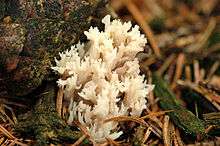Clavulina
| Clavulina | |
|---|---|
 | |
| Clavulina coralloides | |
| Scientific classification | |
| Kingdom: | Fungi |
| Division: | Basidiomycota |
| Class: | Agaricomycetes |
| Order: | Cantharellales |
| Family: | Clavulinaceae |
| Genus: | Clavulina J.Schröt. (1888) |
| Type species | |
| Clavulina cristata (Holmsk.) J.Schröt. (1888) | |
Clavulina is a genus of fungi in the family Clavulinaceae, in the Cantharelloid clade (order Cantharellales).. Species are characterized by having extensively branched fruit bodies, white spore print, and bisterigmate basidia (often with secondary septation). Branches cylindrical or flattened, blunt, pointed or crested at apex. Hyphae with or without clamps. Basidia cylindrical to narrowly clavate, mostly with two sterigmata which are large and strongly incurved. Spores subspherical or broadly ellipsoid, smooth, thin-walled, each with one large oil drop or guttule. [1] The genus contains approximately 45 species with a worldwide distribution, primarily in tropical regions.[2] Species of Clavulina are mostly ectomycorrhizal. A recent study has identified Clavulina to the genera level as present on Nothofagus menziesii adventitious roots[3]
Species
- C. alutaceosiccescens
- C. amazoensis
- C. amethystina
- C. amethystinoides
- C. arcuatus
- C. brunneocinerea
- C. caespitosa
- C. cartilaginea
- C. cavipes
- C. cerebriformis[4]
- C. chondroides
- C. cinerea
- C. cinereoglebosa[4]
- C. cirrhata
- C. coffeoflava
- C. connata
- C. copiosocystidiata
- C. coralloides
- C. craterelloides
- C. decipiens
- C. delicia
- C. dicymbetorum
- C. effusa[4]
- C. floridana
- C. gallica
- C. geoglossoides
- C. gigartinoides
- C. gracilis
- C. griseohumicola
- C. hispidulosa
- C. humicola
- C. humilis
- C. incrustata
- C. ingrata
- C. kunmudlutsa
- C. leveillei
- C. limosa
- C. monodiminutiva
- C. mussooriensis
- C. nigricans
- C. ornatipes
- C. panurensis
- C. puiggarii
- C. purpurea
- C. ramosior
- C. rugosa
- C. samuelsii
- C. septocystidiata
- C. sprucei
- C. subrugosa
- C. tasmanica
- C. tepurumenga
- C. urnigerobasidiata
- C. vinaceocervina
- C. viridula
- C. wisoli
Distribution
Clavulina species are important primary colonizers of forest litter and occur immediately after the pre-monsoon showers. Two species of Clavulina viz., C. coralloides(known as white or crested coral fungus), C. rugosa have been recorded from the moist-deciduous to evergreen forests of the Westrern Ghats, Kerala, India.[1]
References
- 1 2 3 Mohanan C. (2011). Macrofungi of Kerala. Kerala, India: Kerala Forest Research Institute. p. 597. ISBN 81-85041-73-3.
- ↑ Thacker J, Henkel TW. (2004). "New species of Clavulina from Guyana". Mycologia. 96 (3): 650–7. doi:10.2307/3762182. PMID 21148885.
- ↑ Orlovich et al, 2013 Piracy in the high trees: ectomycorrhizal fungi from an aerial 'canopy soil' microhabitat
- 1 2 3 Uehling JK, Henkel TW. (2012). "New species of Clavulina (Cantharellales, Basidiomycota) with resupinate and effused basidiomata from the Guiana Shield". Mycologia. 104 (2): 547–56. doi:10.3852/11-130.